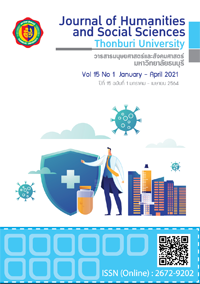Relationship between Sustainable Tourism and Environment: Case Studies of Maldives and Amphawa Floating Market, Thailand
Main Article Content
Abstract
People who like to travel for recreation, are known as tourists. These people are catered for in a huge variety of settings called destinations, which are developed especially for them. These destinations, facilities, and the activities provided for tourists require significant environmental change. By the late 19th century, the scale of global tourism had reached such a size that was concerned by the health of the natural environment. As a result, tourism scholars and operators began to consider destinations with tourism that could operate profitably over the long term but which also protected, and sometimes enhanced, the natural environment. This has known as sustainable tourism. This article shows that over the last 30 years, there has been an increase in concern across a range of economic activities, expanded by owners, managers, industries and politicians need to be found to allow the activities to continue but in a way which protects the environment.
Article Details
References
Amphawa Subdistrict Municipality Samutsongkram. (2016). General Information of Amphawa Subdistrict Municipality. Retrieved on Apr 25, 2020 from http://www.amphawa.go.th.
APEC (1996). Environmentally Sustainable Tourism in APEC member economies. Singapore, APEC Tourism Working Group.
Danpongsuwan, N. (2008). Tourism carrying capacity assessment using an application of recreation opportunity spectrum in classifying the tourism area: A case study of Amphawa Floating Market, Samut Songkhram province. (in Thai). Master thesis, Mahidol University. Retrieved from http://mulinet10.li.mahidol.ac.th/e-thesis/2551/cd421/4936877.pdf
Glasson, J., Godfrey, K., Goodey, B., Absalom and Van der Borg, J. (1995), ‘Tourism carrying capacity’, Towards Visitor Impact Management: Visitor Impacts, Carrying Capacity and Management Responses in Europe’s Historic Towns and Cities, Hants, Avebury, pp. 43-45.
Gluckman, R. (2001), Maldives - Paradise Protected. Retrieved from www. gluckman.com/Maldives.htm
Google Maps. (2020). Thailand Map. Retrieved on Apr 24, 2020 from https://www.google.co.th.
Holden, A. (2008), Environment and Tourism. London, Routledge.
Hunter, C. and Green, H. (1995), Tourism and the Environment: A sustainable relationship?. London: Routledge.
Kim, M. and Thapa, B. (2018, June). Perceived Value and Flow Experience: Application in a Nature-based Tourism Context. Journal of Destination Marketing and Management. 8: 373-384. doi.org/10.1016/j.jdmm.2017.08.002.
Kumar, S.B. (2002). Environmental Problems and Gandhian Solutions: The only ray of hope to the present ailing world. New Delhi, Deep and Deep
Luekveerawattana, S. (2006). Management plan of historical site for case study of Amphawa community. Doctoral thesis, Silpakorn University. Retrieved from http://www.thapra.lib.su.ac.th/thesis/showthesis_th. asp?id=0000001811.
Maldives Marketing and Public Relations Corporation (MMPRC). (2020). Discover Maldives: Geography. Retrieved April 24, 2020 from https://visitmaldives.com/en/Maldives
MaldivesNet.com. (2020). Maldives Map. Retrieved April 24, 2020 from http://www.maldivesnet.com/maldives-map/
Mathieson, A. and Wall, G. (1982), Tourism: economic, physical, and social impacts, pp. 94-95, Essex, Longman Group Limited.
Middleton, V.T.C. and Hawkins, R. (1998). Sustainable tourism: A marketing perspective. Oxford: Butterworth-Heinemann.
Ministry of Finance and Treasury. (2018). Statistical Yearbook of Maldives 2018: Tourism. Retrieved on Apr 25, 2020 from http://statisticsmaldives.gov.mv/yearbook/2018/tourism/
Ministry of Tourism and Sports. (2020). Attraction: Amphawa Floating Market. Retrieved on Apr 25, 2020 from https://thailandtourismdirectory.go.th/th/info/attraction/detail/itemid/2835.
Ministry of Tourism, Arts, and Culture Republic of Maldives (1999). Regulation on the Protection and Conservation of Environment in the Tourism Industry.
Ministry of Tourism, Arts, and Culture Republic of Maldives (2004). Tourist Opinion Survey Report 2004. Retrieved from http://www.tourism.gov.mv/downloads/Surveyreport2004.pdf
Ministry of Tourism, Arts, and Culture Republic of Maldives (2009). Tourism Yearbook 2009. Retrieved from http://www.tourism.gov.mv/downloads/stat_yearbook_2009.pdf
Murphy, P.E. (1985). Tourism: A community approach. New York, U.S., Methuen.
Office of Tourism and Sports Samutsongkram. (2018). Information Service. Retrieved on Apr 25, 2020 from https://samutsongkhram.mots.go.th.
Pollution Control Department. (2017). Publications: Waste Management. Retrieved on Apr 25, 2020 from http://www.pcd.go.th/public/Publications/print_waste.cfm.
Sae-Tang, N., Choowaew, S., Boonratana, R., and Phuted, U. (2015). Environmental Impacts from Boat Excursions at Bueng Borapet Wetland, Nakhon Sawan Province, Thailand. Proceedings of the 3rd Environment Asia International Conference, Thailand, June 17-19, 2015. pp. 324-330.
Sawkar, K., Noronha, L., Mascarenhas, A., Chauhan, O.S., and Saeed, S. (1998). Tourism and the Environment: Case Studies on Goa, India, and the Maldives. The Economic Development Institute of the World Bank, Washington, USA, pp. 20-28.
Silapacharanan, S. (2008). Amphawa: Saving its Spirit of Place. Faculty of Architecture, Chulalongkorn University. Retrieved from http://www.international.icomos.org/quebec2008/cd/toindex/77_pdf/77-koba-15.pdf.
Stabler, M.J. (1997). Tourism and Sustainability: Principles to Practice. Wallingford, Oxford, UK, CAB International.
Sundriyal, S., Shridhar, V., Madhwal, S., Pandey, K., and Sharma, V. (2018). Impacts of Tourism Development on the Physical Environment of Mussoorie, a Hill Station in the Lower Himalayan Range of India. Journal of Mountain Science. 15: 2276-2291.
The Global Development Research Center. (2004). Charter for Sustainable Tourism. Retrieved November 6, 2010 from http://www.gdrc.org/uem/eco-tour/charter.html
The Maldives Tourism Promotion Board. (2010). Maldives: The sunny side of life. Retrieved November 3, 2010 from http://www.visitmaldives.com/en/the-maldives/country-at-a-glance.
The World Tourism Organization (UNWTO). (2009), From Davos to Copenhagen and Beyond: Advancing Tourism’s Response to Climate Change. UNWTO Background Paper.
The World Tourism Organization. (UNWTO). (2020). Glossary of Tourism Terms. Retrieved April 25, 2020 from https://www.unwto.org/glossary-tourism-terms.
United Nations Environment Programme. (1972). Environmental Law Guidelines and Principles: Stockholm Declaration. Retrieved November 1, 2020 from https://wedocs.unep.org/bitstream/handle/20.500. 11822/29567/ELGP1StockD.pdf?sequence=1&isAllowed=y.
Viner, D. and Agnew, M. (1999), Maldives, Indian Ocean: Climate Change and its Impacts on Tourism. from http://intelligenttravel.typepad.com/it/files/tourism_and_cc_full.pdf.

